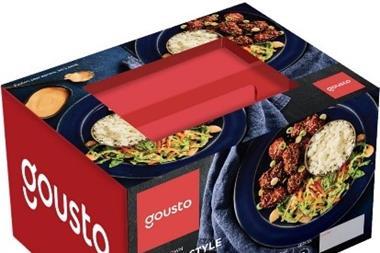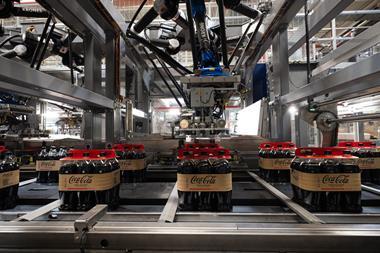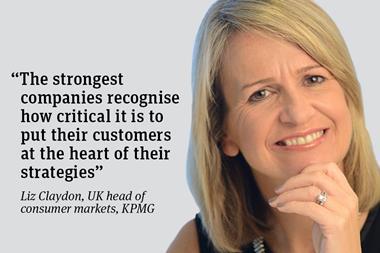2004 is a year Sainsbury will want to forget, with its first-ever loss and a failed £140m investment in IT. Can its new CEO turn its fortunes around? Elaine Watson reports
If 1992 was an annus horribilis for the House of Windsor, 2004 will go down in grocery history as the year Sainsbury proved it was possible to spend £3bn on a business - and make it worse. While new CEO Justin King was not expecting a walk in the park when he took the helm in the spring, the sight of Greenpeace activists dressed up as cows and staging a sit-in in his office before he had even got his feet under the desk should have set the alarm bells ringing.
By July, however, his predecessor’s proverbial finally hit the fan. By October, Sir Peter Davis’s legacy was painfully apparent: three years and £3bn spent on ripping out and replacing almost every IT system in the business, re-engineering an entire supply chain, refurbishing 80% of the store estate and pouring millions into a new non-food range - and sales were still going backwards.
The enormity of the challenge facing King has since emerged through a series of increasingly worrying Stock Exchange announcements, culminating in last month’s revelation that a company that has historically clocked up profits of £700m had plunged £39m into the red and this month’s shock news that its debt rating is one notch above junk status.
Meanwhile, so-called teething problems with the store replenishment system and automated distribution centres have proved so intractable that Sainsbury has been forced to write off a significant part of its investment and continue to move stock through its old network just to keep goods on the shelves.
The Central, Savacentre and Bluebird store formats will be axed; Sainsbury’s to You has been put on ice and £140m in IT systems has been written off. A public spat with Jeff Banks, piles of non-food stock it cannot shift and an embarrassing run-in with Trading Standards, about promotional stock delivered to the wrong stores, have merely added to its woes.
But Sainsbury’s troubles cannot solely be attributed to systems meltdown or an ill-judged non-food debut, say the marketers. Systems failures aside, they point out, Sainsbury is in the middle of an identity crisis. From the infamous Value to Shout About! John Cleese ads and the ill-fated Savacentres to the extravagant Sainsbury’s at Bluebird concept stores, Sainsbury bears all the hallmarks of a company still trying to find itself. Indeed, cynics may even whiff an air of desperation in the latest ad campaign, which concludes with the pleading strapline: ‘With Sainsbury’s putting this much effort into everything, we’re going to have a great Christmas.’
Keith Mills, a director at brand consultancy Dragon, is blunt: “Sainsbury has completely lost the plot. It says it’s going back to basics. But what are the basics of the brand? I don’t think even they know any more.”
In the meantime, Sainsbury has to work harder to justify its price premium by offering something worth paying extra for, claims Interbrand chairman Rita Clifton. “Either they fundamentally change their proposition - probably impossible because they can’t compete solely on price - or they recognise that they already have a good proposition and simply make a better job of executing it. “
To his credit, she adds, King has not rushed in with any bold strategic or marketing shifts, preferring to focus on availability problems and shifting surplus non-food stock. Indeed, keeping the quality and provenance approach to advertising at a time when everything else seems to be in flux was a shrewd move, she says. There has also been a commitment to invest £400m in the customer offer to ensure Sainsbury remains competitive.
With former Asda/Big Food Group man Mike Coupe installed as trading director, ex-T& S boss Jim McCarthy in charge of c-stores and ex-Tesco executive Ken McMeikan arriving soon as retail director, King also has an enthusiastic new management team, even if morale further down the pecking order has been dampened by the prospect of more redundancies in January.
However, scepticism remains over the extent to which suppliers will be expected to contribute to his promised “acceleration in the investment in the customer offer”.
And demands for a 1% reduction in net invoice prices and a new ban on external field marketing agencies are not the most constructive way of building relationships, points out one sales director. He says: “We’ve got a hell of a lot to offer Sainsbury. But this just gets in the way before you can have a conversation about driving the category and so on.
“I don’t think they are becoming the new Safeway, but they are clearly under pressure. In terms of promotions, they are also trying to do fewer, deeper promotions, so are in effect increasing the cost of participating in promotional activity.”
The spectre of 750 head office job cuts widely expected in January does not help much either, adds one supplier. “It’s like the Marie Celeste in my category and everyone is wondering who is going to be next.”
There is nevertheless a lot of goodwill within the supplier community towards King and trading director Coupe, who is seen as “a bit more strait-laced than some, but highly professional”, says another supplier. “The bottom line is that there isn’t a supplier in the marketplace that doesn’t want Sainsbury to recover.”
If 1992 was an annus horribilis for the House of Windsor, 2004 will go down in grocery history as the year Sainsbury proved it was possible to spend £3bn on a business - and make it worse. While new CEO Justin King was not expecting a walk in the park when he took the helm in the spring, the sight of Greenpeace activists dressed up as cows and staging a sit-in in his office before he had even got his feet under the desk should have set the alarm bells ringing.
By July, however, his predecessor’s proverbial finally hit the fan. By October, Sir Peter Davis’s legacy was painfully apparent: three years and £3bn spent on ripping out and replacing almost every IT system in the business, re-engineering an entire supply chain, refurbishing 80% of the store estate and pouring millions into a new non-food range - and sales were still going backwards.
The enormity of the challenge facing King has since emerged through a series of increasingly worrying Stock Exchange announcements, culminating in last month’s revelation that a company that has historically clocked up profits of £700m had plunged £39m into the red and this month’s shock news that its debt rating is one notch above junk status.
Meanwhile, so-called teething problems with the store replenishment system and automated distribution centres have proved so intractable that Sainsbury has been forced to write off a significant part of its investment and continue to move stock through its old network just to keep goods on the shelves.
The Central, Savacentre and Bluebird store formats will be axed; Sainsbury’s to You has been put on ice and £140m in IT systems has been written off. A public spat with Jeff Banks, piles of non-food stock it cannot shift and an embarrassing run-in with Trading Standards, about promotional stock delivered to the wrong stores, have merely added to its woes.
But Sainsbury’s troubles cannot solely be attributed to systems meltdown or an ill-judged non-food debut, say the marketers. Systems failures aside, they point out, Sainsbury is in the middle of an identity crisis. From the infamous Value to Shout About! John Cleese ads and the ill-fated Savacentres to the extravagant Sainsbury’s at Bluebird concept stores, Sainsbury bears all the hallmarks of a company still trying to find itself. Indeed, cynics may even whiff an air of desperation in the latest ad campaign, which concludes with the pleading strapline: ‘With Sainsbury’s putting this much effort into everything, we’re going to have a great Christmas.’
Keith Mills, a director at brand consultancy Dragon, is blunt: “Sainsbury has completely lost the plot. It says it’s going back to basics. But what are the basics of the brand? I don’t think even they know any more.”
In the meantime, Sainsbury has to work harder to justify its price premium by offering something worth paying extra for, claims Interbrand chairman Rita Clifton. “Either they fundamentally change their proposition - probably impossible because they can’t compete solely on price - or they recognise that they already have a good proposition and simply make a better job of executing it. “
To his credit, she adds, King has not rushed in with any bold strategic or marketing shifts, preferring to focus on availability problems and shifting surplus non-food stock. Indeed, keeping the quality and provenance approach to advertising at a time when everything else seems to be in flux was a shrewd move, she says. There has also been a commitment to invest £400m in the customer offer to ensure Sainsbury remains competitive.
With former Asda/Big Food Group man Mike Coupe installed as trading director, ex-T& S boss Jim McCarthy in charge of c-stores and ex-Tesco executive Ken McMeikan arriving soon as retail director, King also has an enthusiastic new management team, even if morale further down the pecking order has been dampened by the prospect of more redundancies in January.
However, scepticism remains over the extent to which suppliers will be expected to contribute to his promised “acceleration in the investment in the customer offer”.
And demands for a 1% reduction in net invoice prices and a new ban on external field marketing agencies are not the most constructive way of building relationships, points out one sales director. He says: “We’ve got a hell of a lot to offer Sainsbury. But this just gets in the way before you can have a conversation about driving the category and so on.
“I don’t think they are becoming the new Safeway, but they are clearly under pressure. In terms of promotions, they are also trying to do fewer, deeper promotions, so are in effect increasing the cost of participating in promotional activity.”
The spectre of 750 head office job cuts widely expected in January does not help much either, adds one supplier. “It’s like the Marie Celeste in my category and everyone is wondering who is going to be next.”
There is nevertheless a lot of goodwill within the supplier community towards King and trading director Coupe, who is seen as “a bit more strait-laced than some, but highly professional”, says another supplier. “The bottom line is that there isn’t a supplier in the marketplace that doesn’t want Sainsbury to recover.”













No comments yet